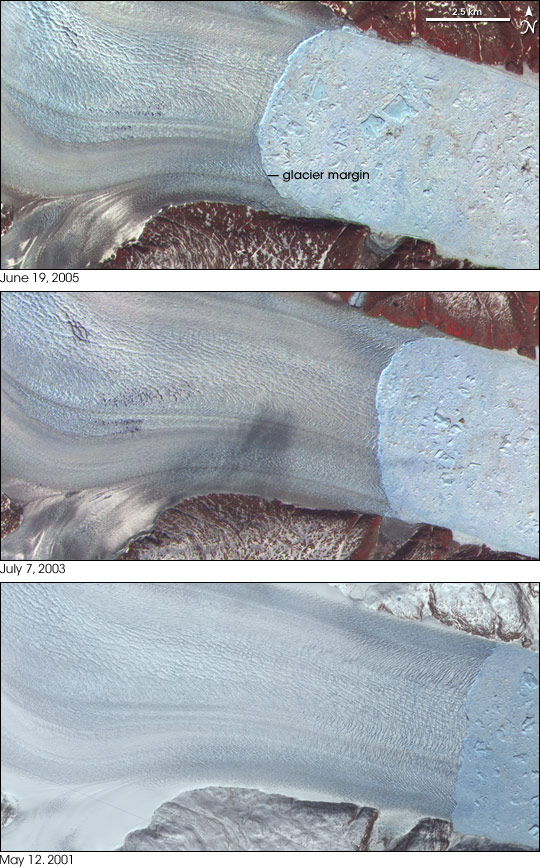


Along the margin of the Greenland Ice Sheet, outlet glaciers flow as icy rivers through narrow fjords and out to sea. As long as the thickness of the glacier and the depth of the water allow the ice to remain grounded, it stays intact. Where the ice becomes too thin or the water too deep, the edge floats and rapidly crumbles into icebergs. Satellite observations of eastern Greenland’s Helheim Glacier show that the position of the iceberg’s calving front, or margin, has undergone rapid and dramatic change since 2001, and the glacier’s flow to the sea has sped up as well.
These images from the Advanced Spaceborne Thermal Emission and Reflection Radiometer (ASTER) on NASA’s Terra satellite show the Helheim glacier in June 2005 (top), July 2003 (middle), and May 2001 (bottom). The glacier occupies the left part of the images, while large and small icebergs pack the narrow fjord in the right part of the images. Bare ground appears brown or tan, while vegetation appears in shades of red.
From the 1970s until about 2001, the position of the glacier’s margin changed little. But between 2001 and 2005, the margin retreated landward about 7.5 kilometers (4.7 miles), and its speed increased from 8 to 11 kilometers per year. Between 2001 and 2003, the glacier also thinned by up to 40 meters (about 131 feet). Scientists believe the retreat of the ice margin plays a big role in the glacier’s acceleration. As the margin of the glacier retreats back toward land, the mass of grounded ice that once acted like a brake on the glacier’s speed is released, allowing the glacier to speed up.
Overall, the margins of the Greenland Ice Sheet have been thinning by tens of meters over the last decade. At least part of the thinning is because warmer temperatures are causing the ice sheet to melt. But the other part of the thinning may be due to changes such as glacier acceleration like that seen at Helheim. Initial melting due to warming may set up a chain reaction that leads to further thinning: the edge of the glacier melts and thins, becomes ungrounded and rapidly disintegrates. The ice margin retreats, the glacier speeds up, and increased calving causes additional thinning. Understanding the dynamic interactions between temperature, glacier flow rates, and ice thickness is crucial for scientists trying to predict how the Greenland Ice Sheet will respond to continued climate change.
NASA images created by Jesse Allen, Earth Observatory, using data provided courtesy of NASA/GSFC/METI/ERSDAC/JAROS, and the U.S./Japan ASTER Science Team.